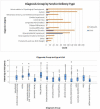Rapid Implementation of Telerehabilitation for Pediatric Patients During Covid-19
- PMID: 34345345
- PMCID: PMC8287708
- DOI: 10.5195/ijt.2021.6371
Rapid Implementation of Telerehabilitation for Pediatric Patients During Covid-19
Erratum in
-
Errata.Int J Telerehabil. 2021 Jun 22;13(1):e6386. doi: 10.5195/ijt.2021.6386. eCollection 2021. Int J Telerehabil. 2021. PMID: 34374704 Free PMC article.
Abstract
The COVID-19 pandemic necessitated a sudden limitation of in-person outpatient occupational and physical therapy services for most patients at a large, multisite pediatric hospital located in the Midwest, United States. To ensure patient and staff safety, the hospital rapidly shifted to deliver most of these services via telerehabilitation. The purposes of this study were to (1) describe the rapid implementation of telerehabilitation during the COVID-19 pandemic, (2) describe the demographic characteristics of patients who continued in-person services and those who received telerehabilitation, and (3) evaluate the therapists' perceptions of telerehabilitation for physical and occupational therapy. Most of the children (83.4% of n=1352) received telerehabilitation services. A family was more likely to choose to continue in-person visits if their child was <1-year-old, had a diagnosis of torticollis, received serial casting, or was post-surgical. Occupational and physical therapy therapists (n=9) completed surveys to discern their perceptions of the acceptability of telerehabilitation, with most reporting that telerehabilitation was as effective as in-person care.
Keywords: Covid-19; Occupational Therapy; Pediatrics; Physical Therapy; Telehealth; Telerehabilitation.
Copyright © 2021 Rachel Bican, Catie Christensen, Kristin Fallieras, Grace Sagester, Sara O'Rourke, Michelle Byars, Kelly Tanner.
Figures
Similar articles
-
Feasibility and Acceptability of Clinical Pediatric Telerehabilitation Services.Int J Telerehabil. 2020 Dec 8;12(2):43-52. doi: 10.5195/ijt.2020.6336. Int J Telerehabil. 2020. PMID: 33520094 Free PMC article.
-
Exploring Practice Patterns of Pediatric Telerehabilitation During COVID-19: A Survey Study.Telemed J E Health. 2022 Oct;28(10):1505-1516. doi: 10.1089/tmj.2021.0506. Epub 2022 Mar 9. Telemed J E Health. 2022. PMID: 35263191 Free PMC article.
-
Physical therapists' perceptions of telerehabilitation for patients with musculoskeletal conditions in a post-pandemic world.medRxiv [Preprint]. 2025 Jan 18:2025.01.17.25320739. doi: 10.1101/2025.01.17.25320739. medRxiv. 2025. PMID: 39867367 Free PMC article. Preprint.
-
Pediatric telerehabilitation medicine: Making your virtual visits efficient, effective and fun.J Pediatr Rehabil Med. 2020;13(3):355-370. doi: 10.3233/PRM-200748. J Pediatr Rehabil Med. 2020. PMID: 33136081 Review.
-
Acceptability of Pediatric Telerehabilitation Interventions Provided by Physical Therapists and Occupational Therapists-A Scoping Review.Phys Occup Ther Pediatr. 2022;42(6):615-634. doi: 10.1080/01942638.2022.2064203. Epub 2022 Apr 19. Phys Occup Ther Pediatr. 2022. PMID: 35440285
Cited by
-
Telerehabilitation Policy Report: Interprofessional Policy Principles and Priorities.Int J Telerehabil. 2021 Dec 16;13(2):e6433. doi: 10.5195/ijt.2021.6433. eCollection 2021. Int J Telerehabil. 2021. PMID: 35646236 Free PMC article.
-
Telerehabilitation Policy Report: Interprofessional Policy Principles and Priorities.Int J Telerehabil. 2025 Jan 15;16(2):e6687. doi: 10.5195/ijt.2024.6687. eCollection 2025. Int J Telerehabil. 2025. PMID: 39927079 Free PMC article.
-
Effectiveness of a 5-Week Virtual Reality Telerehabilitation Program for Children With Duchenne and Becker Muscular Dystrophy: Prospective Quasi-Experimental Study.JMIR Serious Games. 2023 Nov 15;11:e48022. doi: 10.2196/48022. JMIR Serious Games. 2023. PMID: 37990809 Free PMC article.
-
The Evolution of Telehealth From Pre-COVID-19 Pandemic Through A Hybrid Virtual Care Delivery Model: A Pediatric Hospital's Journey.Int J Telerehabil. 2021 Dec 16;13(2):e6432. doi: 10.5195/ijt.2021.6432. eCollection 2021. Int J Telerehabil. 2021. PMID: 35646232 Free PMC article.
-
Factors Facilitating and Inhibiting the Implementation of Telerehabilitation-A Scoping Review.Healthcare (Basel). 2024 Mar 8;12(6):619. doi: 10.3390/healthcare12060619. Healthcare (Basel). 2024. PMID: 38540583 Free PMC article.
References
-
- American Physical Therapy Association. (2019). Position on telehealth. American Physical Therapy Association. https://www.apta.org/apta-and-you/leadership-and-governance/policies/tel...
-
- Baldwin, P., King, G., Evans, J., McDougall, S., Tucker, M. A., & Servais, M. (2013). Solution-focused coaching in pediatric rehabilitation: An Integrated model for practice. Physical & Occupational Therapy in Pediatrics, 33(4), 467–483. - PubMed
LinkOut - more resources
Full Text Sources





